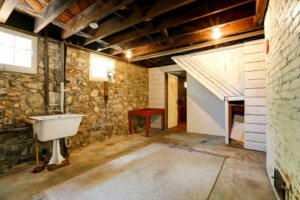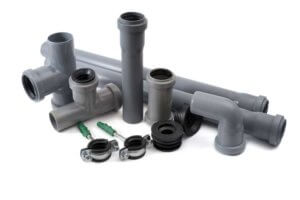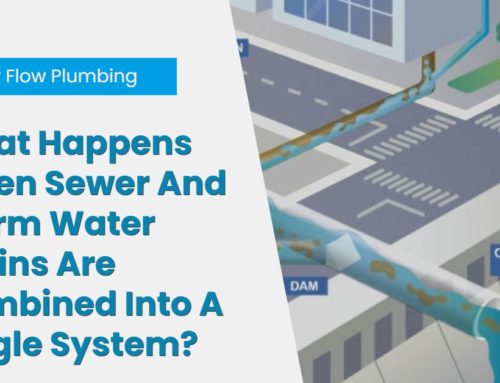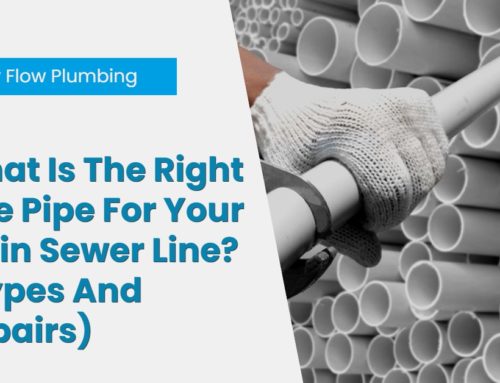How To Replace Sewer Pipe In The Basement
If you’re looking for information on how to replace sewer pipe in the basement, you’ve come to the right place. In this article we’re going to go over the basics of how your home’s drainage system works, talk about symptoms of sewer line problems, go over slab leaks and how to detect them, and finish up by explaining how to replace sewer pipe in the basement via today’s trenchless methods.

Your home’s drainage system
If you’re not sure how your home’s drainage system works, you’re not alone. Many – or maybe even most – homeowners have only a general idea about how it works. So, here goes…
You have two pipe systems in your house: water and wastewater.
Water pipes bring clean, drinkable water into your house when you turn on the kitchen faucet or take a shower. Water pipes are not part of your home’s drainage system.
Wastewater pipes carry dirty water out of your house via either a drain pipe or a waste pipe. For example, when the dishwater goes down the drain it’s carried away via a drain pipe. When you flush the toilet, the wastewater is carried away via a waste pipe. When both kinds of wastewater leave your home they go either to a septic tank on your property somewhere, or to the city’s main line in the street, and from there to a wastewater treatment facility.
There are also a series of vent pipes. These keep wastewater moving freely away from your home, and make sure sewer gas doesn’t enter your home.
Both the drain and the waste pipes are around 2 inches in diameter and empty into the building’s main line, which is under the slab and approximately 4 inches in diameter. (The locations where these pipes empty into the building’s main line depend on the building’s specific layout.) From the building’s main line the wastewater is then transported via one lateral line to either a septic tank or to the city main line in the street. This lateral line might run under a driveway, a yard, a parking lot, or something else. So, the flow of wastewater out of your home is as follows…
Individual drains > building main > lateral line > septic tank or city main.
Building main lines usually have at least a couple of cleanouts. Cleanouts are capped access points that allow homeowners or professional plumbing technicians to get into the system in order to break up clogs. All homeowners should know the location of their cleanouts and where their lateral line connects to the city main.
Why basement sewer pipes need to be replaced eventually
As pipes age, they become brittle and can easily crack. This allows tree roots to enter, grow, and make the problem even worse. If tree roots aren’t removed, they will eventually cause the pipe to break. When this happens, the pipe will need to be replaced.
If you’re living in a home built before the 1980s, your sewer pipes are probably made from iron, clay, or orangeburg pipe, a combination of wood fiber and pitch. While cast iron pipes can, theoretically, last a long time under the right conditions, clay and orangeburg pipe will almost certainly need to be replaced after 50-60 years.

Symptoms of basement sewer pipe problems
Signs of a basement sewer pipe problems include…
- Frequent and unexplained clogged drains and toilet backups. Learn more about: Reasons of Toilets Bubble
- Water coming up through your basement floor.
- Unpleasant odors in your basement. This might be from the sewer line leak itself or from mold caused by the excess moisture.
- Water pooling in your yard.
- Areas in your yard that are spongy or greener than the surrounding vegetation.
- Foundation damage.
- Wall cracks.
What is a slab leak?
If your home doesn’t have a basement or a crawl space, it sits directly atop a concrete slab. The building’s main line is located under this slab and if it breaks, you’ll get a slab leak. Wastewater will leak out of the pipe and into the ground under your foundation. If you don’t act quickly to repair a slab leak, it will eventually cause significant damage to your foundation.
How to detect a slab leak
Signs of a slab leak include…
- Wet or warm spots on the floor. You could even see pools of water.
- The sound of water moving under the slab even though there’s no faucet running.
- Mold on anything that sits on the slab, including furniture and rugs.
- Cracks in your foundation along the inside walls or floors, or cracks along the lower, outside area of your foundation. Slab leaks can compromise a foundation and lead to significant damage.
Is replacing sewer pipe in a basement a DIY project?
While it’s certainly possible to replace basement sewer pipe yourself, it’s a difficult and smelly job. You’ll need both knowledge and manpower. If you don’t know what you’re doing, you could make a mess of things and then end up paying a plumbing contractor to fix it. However, if you think you’re up to the challenge, you can probably find instructions online. We can’t guarantee their quality though.

How do plumbers find breaks beneath the slab?
Sewer repair contractors today can easily find sewer line breaks under your home’s slab via a CCTV sewer camera inspection. This is a non-destructive, approximately 30-minute procedure that allows plumbers to see inside the pipe. They’ll be able to easily find out what’s going on. They’ll then use this information to suggest a repair option. Unless the pipe is back-pitched or collapsed, it will probably be a trenchless repair method.
Replacing sewer pipe in the basement via trenchless sewer repair
In the not-so-distant past, sewer repair and replacement involved digging big trenches and performing heavy excavation. That all changed with minimally-invasive trenchless methods. Today, except for a handful of problems, most sewer repair and replacement can be done without destroying your property. In other words, once the repair is complete, you won’t have a big, expensive mess to clean up. Visit our pages on trenchless sewer repair, sewer pipe lining, and pipe bursting for more information.
Read also: Pros and cons of trenchless sewer repair
If you have a problem with the sewer pipe under your basement or slab, it’s best to call a professional sewer repair contractor. They’ll come out, perform a CCTV sewer camera inspection, find out exactly what’s wrong, and then fix it, probably using a minimally-invasive trenchless method. If you DIY, you could cause even more damage.




